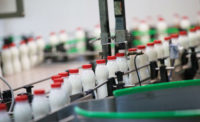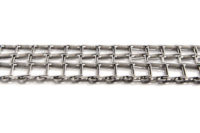
Belting it Out
by Lynn Petrak
Conveyors and belting systems built for product and performance help processors with material handling.
While some automated
systems are considered the heart or brain of production, conveyors can be
considered the veins and arteries that move ingredients, packages and
finished product throughout a facility.
As dairy operations — whether they are devoted
to fluid milk, cheese, ice cream, cultured products or dry ingredients
— become increasingly sophisticated, continuous and automated,
belting and conveyors are the conduits that allow for the reduction of
labor and more streamlined way of getting things from point A to point B
(or, for that matter, to points C, D or E.)
With an increasing role in product handling,
packaging, palletizing and other functions, belting and conveyors have
become a focus of investment for processors who want to keep their lines
rolling along at the pace of business. In turn, material and equipment
suppliers are working on systems designed to meet their customers’
changing and often specific needs, whether they are using floor, case
handling, overhead, cable, package, palletizing, tabletop models or other
types of systems.
Need for Speed
As volume and throughput remain key drivers in
manufacturing, it’s not surprising that speed influences conveyor
design. “We’re seeing an increased emphasis on speed, with some
people running in excess of 300 bottles a minute,” reports Paul
Calabretta, new business development for Dairy Conveyor Corp., a Brewster,
N.Y.-based company specializing in the design, engineering, manufacturing,
installation and service of conveyor systems for food industries.
Swiftness is a trend also noted by Brian Benson, vice
president of sales for dairy for Rosemount, Minn.-based Cannon Equipment,
which provides automated solutions, including conveyors, for food and
beverage processing. “Speed is an issue. A lot of people are talking
about continuous speed,” he says.
Likewise, Arlen Johnson, regional sales manager for
Nol-Tec Systems Inc., a Lino Lakes, Minn.-based industrial automation and
pneumatic conveying company specializing in bulk material handling and
system integration, has fielded similar requests from dairy processors
related to speed. “Speed is always a concern. They want to be able to
do a certain rate today with the understanding that the rate can double
later. They want a certain amount of that design built into it as much as
possible,” he says. “Everyone is looking to maximize their
output.”
The flexibility that Johnson alludes to is also
evident in the growing number of processors who use adjustable speeds on
their conveyors. “People are looking at variable speeds,”
Benson says. “If they want to slow it down or adjust the speed to
match the input or output they can without changing sprockets.”
Having variable speeds for conveyors also allows
processors to help contain energy costs. “We are selling more
high-efficiency motors, and we are also seeing an increase in the number of
customers who want motor control systems to run systems more
efficiently,” Calabretta says.
New Products, New Uses
In addition to upping speed, dairy manufacturers are
also using conveyors for new products and in new places within their
plants.
Calabretta, for instance, cites the continuing move
toward smaller bottles of milk and dairy-based drinks. “There is an
increasing proliferation of small, round bottles, which means an increased
use of vacuum conveyors,” he says. “We also are selling more
side-gripping elevators and lowerators because the small bottle is more
unstable.”
The fact that dairies are expanding their product
lines and types of packages has also led to features that can be tweaked.
Benson cites the growing use of adjustable rails as an example.
“Depending on the product, if you run multiple products, the rail has
to be adjustable so the items don’t have to go around each other on
the conveyor,” he explains.
Meantime, as the market for ingredients like whey and
milk powder has continued to grow internationally, dry dairy ingredients
processors are updating their equipment, including conveyor systems.
Nol-Tec provides pneumatic conveying systems for such applications.
“It’s all a contained system, a dust-free, low-maintenance
system that eases labor and helps reduce possible injuries,” Johnson
says of the company’s Dense Phase and Dilute Phase conveying systems.
Even as high-speed, high-capacity conveying systems
reflect many trends in the dairy industry, Johnson reports that there is
strong interest in Nol-Tec’s Mini Jet as well. “It’s a
small, inexpensive system to install and run and we do a lot with it in
cheese plants,” he says. “It is cost effective for capital
expenditures as well as operating costs.”
Further down the line in a plant, there are new ways
in which conveyors are being used in packaging and palletizing. “I
think the most significant trend right now is organic milk – we are
selling more conveyors for corrugated and cardboard boxes,”
Calabretta says. “Instead of product going into a dairy case, we
continue to see more and more going to boxes, and organic is driving that,
along with ESL half-gallon cartons.”
That evolution can be wider in scope, Calabretta
predicts. “Not only that, but we are seeing dairies pushing to get
out of milk cases wherever they can because they are costing them a ton of
money,” he observes.
Where conveyors come into that picture, he adds, is
the switch to robotic palletizers. “Since boxes are usually three or
six half gallons to a box, they want to be able to robotically palletize
them because it can be a very labor intensive process,” he says.
Tailor Made
Given the fact that product diversity and
manufacturing realities require processors to be more flexible than ever,
belt conveyors are increasingly engineered for a manufacturer’s
unique set of circumstances.
That is certainly the case at Cannon Equipment, Benson
says. “The bottom line is that we basically build the customer a
product they nee,” he says. “We are not saying, ‘We only
offer a certain type of conveyor.’ We try to match the
customer’s needs to what they want to do, whether it’s
accumulation nor carry through.”
At Nol-Tec, Johnson says that what the company offer
to its customers isn’t so much a certain model but a solution.
”We design equipment specifically for the application, so we are
constantly changing and updating. It almost has to be a custom system,
because every application is different,” he says, noting that while
components are standard, the overall systems vary from plant to plant.
Material for Material Handling
As with other types of equipment used in automated
systems in dairy facilities, belting and conveyors are increasingly
designed for sanitation as well. For example, stainless-steel construction
is on the wish list for many manufacturers.
“Everyone wants stainless,” Benson says,
adding that even as the cost of stainless steel is rising, the ROI is still
attractive. “Stainless wipes off when you clean it and it is cheaper
in the long run because you don’t have to do maintenance or upkeep
like other equipment. Also, many years down the road a steel painted system
looks older, while stainless always looks nice.” Getting the right
type of stainless — “not low-grade stainless than can
rust” — is an important consideration, he adds.
Compared to previous years, the latest belts are
created to be quick and easily sanitized. For instance, Volta Belting
Technology Ltd., a Dallas-based supplier of homogenous conveyor belts, has
improved the sanitation features of its belting systems, including its
SuperDrive®, which features a smoother surface to prevent bacteria
growth that might otherwise occur in crevices and easy-to-clean
“teeth” that mesh with the teeth on the drive pulley.
Lynn Petrak is a freelance journalist based in the
Chicago area.
$OMN_arttitle="Belting it Out";?>
$OMN_artauthor="Lynn Petrak";?>
